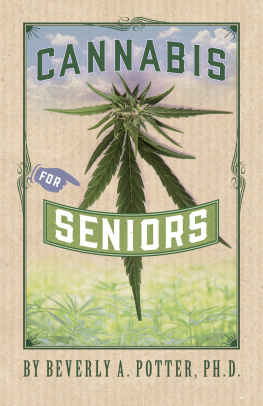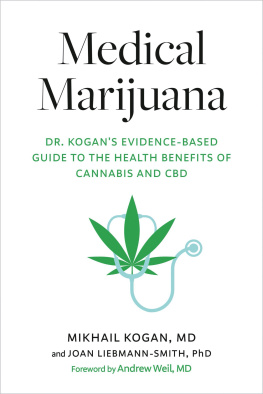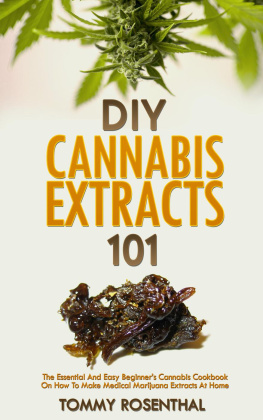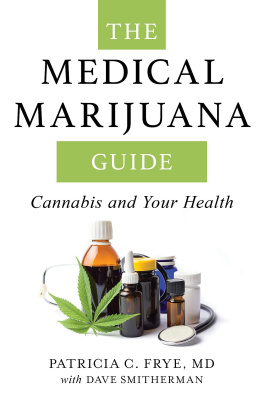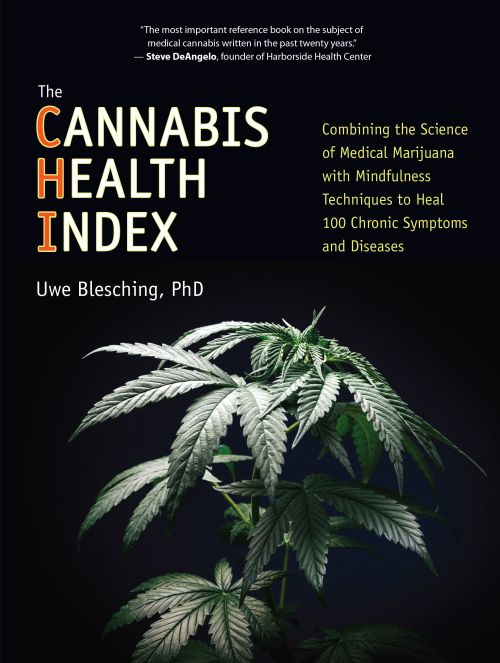The
CANNABIS HEALTH INDEX
Combining the Science of Medical Marijuana with Mindfulness Techniques to Heal 100 Chronic Symptoms and Diseases
Uwe Blesching, PhD

North Atlantic Books
Berkeley, California
Copyright 2013, 2015 by Uwe Blesching. All rights reserved. No portion of this book, except for brief review, may be reproduced, stored in a retrieval system, or transmitted in any form or by any meanselectronic, mechanical, photocopying, recording, or otherwisewithout the written permission of the publisher. For information contact North Atlantic Books.
Published by
North Atlantic Books
Berkeley, California
Cover photo underworld/shutterstock.com
Cover design by Howie Severson
The Cannabis Health Index: Combining the Science of Medical Marijuana with Mindfulness Techniques to Heal 100 Chronic Symptoms and Diseases is sponsored and published by the Society for the Study of Native Arts and Sciences (dba North Atlantic Books), an educational nonprofit based in Berkeley, California, that collaborates with partners to develop cross-cultural perspectives, nurture holistic views of art, science, the humanities, and healing, and seed personal and global transformation by publishing work on the relationship of body, spirit, and nature.
North Atlantic Books publications are available through most bookstores. For further information, visit our website at www.northatlanticbooks.com or call 800-733-3000.
MEDICAL DISCLAIMER: The following information is intended for general information purposes only. Individuals should always see their health care provider before administering any suggestions made in this book. Any application of the material set forth in the following pages is at the readers discretion and is his or her sole responsibility.
DISCLAIMER: The following information is intended for general information purposes only. The publisher does not advocate illegal activities but does believe in the right of individuals to have free access to information and ideas. Any application of the material set forth in the following pages is at the readers discretion and is his or her sole responsibility.
Library of Congress Cataloging-in-Publication Data
Blesching, Uwe, 1958
The cannabis health index : combining the science of medical marijuana with mindfulness techniques to heal 100 chronic symptoms and diseases / Uwe Blesching, PhD.
pages cm
First published: Berkeley, Calif. : Logos Publishing House, [2013].
ISBN 978-1-58394-962-7 (pbk.) ISBN 978-1-58394-963-4 (ebook)
1. CannabisTherapeutic use. 2. MarijuanaTherapeutic use. 3. Medicine, Psychosomatic. 4. Mind and body. I. Title.
RM666.C266B54 2015
615.7827dc23
2014043656
CONTENTS
Allow me to tell you the story of how, when I was a mobile intensive-care paramedic in San Francisco, I witnessed the murder of a patient and how my partner and I used magic to bring him back to life.
It was late, a few hours past midnight, and the storefront lights on Chestnut Street were dim. The streets were empty except for some late-night clubbers looking for a taxi. We had been working a string of highly stressful emergencies nonstop for twenty-three hours with no sleep and little time to eat. We were burned out in attitude and exhausted in body when we got a call for an unconscious person lying on the sidewalk.
Lights and sirens on, our ambulance was briefly airborne as we flew over the top of the steep hill on Franklin. We came down hard and sped on until we found the person lying face down on the sidewalk in front of an elegant store selling evening gowns. He was oozing bodily fluids from every orifice.
We did a quick, head-to-toe assessment: no signs of blood or broken bones, blood test for sugar within normal limits, no sign of recent injection. The patients pupils were dilated, so we could rule out narcotics overdose. I got the gurney and aligned it next to his limp 220-pound body. Lifting him was difficult and strenuous. Once he was in the ambulance, I placed an EKG monitor on his chest and fitted an oxygen mask over his face. He was breathing okay; pulse oximeter was a bit low but not too bad; his cardiac rhythm was normal.
My partner, as he was trying to adjust the gurneys safety belts, slipped. He tried to break his fall by bracing himself against the gurney and his hand ended up in the wet, warm puddle that had pooled between the patients legs.
Just die, he said, following up this fatigue-induced directive with an expletive.
I looked at the monitor at that very moment. The patients normal heart rhythm instantly flat-lined. My partner and I looked at each other. All of our exhaustion and bad attitude was washed away by an immediate flood of adrenalin. We initiated CPR, and I placed a tube in the patients lungs while my partner hooked up an intravenous line.
I injected the first ampule of epinephrine into his system. No response. He was still flat-lining.
Without making the conscious connection to what had happened a few minutes earlier, I yelled, Come on! Stay with us!
Nothing happened.
Come back! I shouted again, but this time I followed the command with a colorful expletive. To my surprise and instant relief, his heart started to beat again. His breathing returned spontaneously and his oxygen saturation improved dramatically.
The rest of the transport to the emergency room was uneventful. Later we learned that our passenger had overdosed on GHB (a euphoria-inducing substance known to most people as the date rape drug). The patient was kept at the hospital for a day and released the next morning with no complications.
I, however, was put on a fast track to studying anything I could find about mind-body medicine and that elusive bridge between them. Little did I know that the scientific evidence would lead me directly to the recent discovery of the bodys own endocannabinoid system.
Youre sick with a chronic condition. In a world of cause and effect, the exact cause of most chronic illnesses escapes modern medicine. To make things worse, cures are few and far between. In many cases, the best you can hope for is to be managed by pharmaceuticals... in other words, by the mighty corporate world.
Should you manage to make it to the doctors office, what may make you even sicker is to find out the hard way that only about 15% of medical interventions are actually based on solid scientific evidence. Even if the actual evidence were double that estimate, it would still seem like a walk somewhere between a wish and a prayer.
How can that be? For instance, when Vioxx entered the market it was approved (i.e., tested for) an immune deficiency disease called rheumatoid arthritis. However, once it was on the market, doctors quickly began prescribing it to patients with various conditions, a common practice called off-label use. By the time the medical community caught up with the deadly reality, Vioxx had killed an estimated 55,000 to 500,000 patients by causing heart attacks and strokes. The company settled the resulting class-action lawsuit for a little less than US$5 billion. Sounds tough, but they still made about ten billion in revenue over the life of the drug.



